Assessing EFL (English as Foreign Language) Education for Sustainable Development: Exploring the Cultural Teaching Literature
Abstract
1. Introduction
2. Literature Review
3. Data and Method
3.1. Data
3.2. Research Method
4. Results
4.1. Research Distribution
4.1.1. Research Distribution by Regions
4.1.2. Research Distribution by Authors and Co-Cited Authors
4.2. Hot Topic Analysis
4.2.1. Keyword Co-Occurrence Analysis
4.2.2. Keyword Clusters Analysis
4.3. Evolution of Frontier Research
5. Discussions
5.1. Establishing an Academic Community of Inclusion and Cultural Diversity
5.2. Promoting Interculturality of EFL Education
5.2.1. Interculturality of Teachers
5.2.2. Interculturality of Students/Learners
5.2.3. Interculturality of Textbooks
5.3. Highlighting the Multilingual Trend
6. Conclusions and Implications
7. Limitations
Author Contributions
Funding
Institutional Review Board Statement
Informed Consent Statement
Data Availability Statement
Conflicts of Interest
References
- Education for Sustainable Development Goals: Learning Objectives. Available online: https://unesdoc.unesco.org/ark:/48223/pf0000247444 (accessed on 7 February 2024).
- Trudell, B. Local-language literacy and sustainable development in Africa. Int. J. Educ. Dev. 2009, 29, 73–79. [Google Scholar] [CrossRef]
- Gayatri, P.; Sit, H.; Chen, S.; Li, H. Sustainable EFL blended education in Indonesia: Practical recommendations. Sustainability 2023, 15, 2254. [Google Scholar] [CrossRef]
- Zhang, P.; Thilak, K.D.; Ravi, R.V. Big data analytics and augmentative and alternative communication in EFL teaching. Int. J. Speech Technol. 2022, 25, 1–15. [Google Scholar] [CrossRef]
- Sharma, V. Developing Communication Skills through Raising Intercultural Competence in EFL Classroom. Asian Soc. Res. 2021, 2, e2020005. [Google Scholar] [CrossRef]
- Rohmani, L.A.; Andriyanti, E. Culture teaching in EFL classes: Teachers’ beliefs, attitudes, and classroom practices. Stud. Engl. Lang. Educ. 2022, 9, 237–257. [Google Scholar] [CrossRef]
- UNESDOC. UNESCO Guidelines on Intercultural Education. 2006. Available online: https://unesdoc.unesco.org/ark:/48223/pf0000147878/PDF/147878eng.pdf.multi/2006 (accessed on 7 February 2024).
- Chinese Ministry of Education. English Curriculum Standards for Senior High School (Experimental Draft). 31 March 2003. Available online: http://www.moe.gov.cn/srcsite/A26/s8001/200303/W020200401347863199102.pdf (accessed on 7 February 2024).
- Chinese Ministry of Education. 30 January 2007. Available online: http://www.moe.gov.cn/srcsite/A08/s7056/200401/t20040130_110837.html (accessed on 7 February 2024).
- Kong, D.L.; Luan, S.W. Construction of modes for cross-cultural college English Teaching—The status quo and theoretical reflection. Foreign Lang. World 2012, 2, 17–26. [Google Scholar]
- Liu, L. Co-citation analysis of works and drawing of scientific maps. Stud. Sci. Sci. 2005, 2, 155–159. [Google Scholar]
- Shen, Z.; Ji, W.; Yu, S.; Cheng, G.; Yuan, Q.; Han, Z.; Liu, H.; Yang, T. Mapping the knowledge of traffic collision Reconstruction: A scientometric analysis in CiteSpace, VOSviewer, and SciMAT. Sci. Justice 2023, 63, 19–37. [Google Scholar] [CrossRef] [PubMed]
- Chen, C.; Ibekwe-SanJuan, F.; Hou, J. The structure and dynamics of cocitation clusters: A multiple-perspective cocitation analysis. J. Am. Soc. Inf. Sci. Technol. 2010, 61, 1386–1409. [Google Scholar] [CrossRef]
- Chien, S.Y.; Hwang, G.J.; Jong, M.S.Y. Effects of peer assessment within the context of spherical video-based virtual reality on EFL students’ English-Speaking performance and learning perceptions. Comput. Educ. 2020, 146, 103751. [Google Scholar] [CrossRef]
- Zou, B.; Huang, L.; Ma, W.; Qiu, Y. Evaluation of the effectiveness of EFL online teaching during the COVID-19 pandemic. Sage Open 2021, 11, 21582440211054491. [Google Scholar] [CrossRef]
- Derakhshan, A.; Kruk, M.; Mehdizadeh, M.; Pawlak, M. Boredom in online classes in the Iranian EFL context: Sources and solutions. System 2021, 101, 102556. [Google Scholar] [CrossRef]
- Yang, Q.F.; Chang, S.C.; Hwang, G.J.; Zou, D. Balancing cognitive complexity and gaming level: Effects of a cognitive complexity-based competition game on EFL students’ English vocabulary learning performance, anxiety and behaviors. Comput. Educ. 2020, 148, 103808. [Google Scholar] [CrossRef]
- Noori, A.Q.; Orfan, S.N.; Akramy, S.A.; Hashemi, A. The use of social media in EFL learning and teaching in higher education of Afghanistan. Cogent Soc. Sci. 2022, 8, 2027613. [Google Scholar] [CrossRef]
- Chen, H.H.J.; Yang, C.T.Y.; Lai, K.K.W. Investigating college EFL learners’ perceptions toward the use of Google Assistant for foreign language learning. Interact. Learn. Environ. 2023, 31, 1335–1350. [Google Scholar] [CrossRef]
- Kudryashova, A.V.; Sidorenko, T.V. Corpus Software in EFL Teaching: Examination of Language Exposure. Образoвание и наука 2020, 22, 131–145. [Google Scholar] [CrossRef]
- Ghufron, M.A.; Nurdianingsih, F. Flipped Teaching with CALL Media in EFL Writing Course: Indonesian EFL Writing Teachers’ Reflection. Pertanika J. Soc. Sci. Humanit. 2020, 28, 1–18. [Google Scholar]
- Park, M.; Son, J.B. Pre-service EFL teachers’ readiness in computer-assisted language learning and teaching. Asia Pac. J. Educ. 2022, 42, 320–334. [Google Scholar] [CrossRef]
- Zou, D. Gamified flipped EFL classroom for primary education: Student and teacher perceptions. J. Comput. Educ. 2020, 7, 213–228. [Google Scholar] [CrossRef]
- Albashtawi, A.; Al Bataineh, K. The effectiveness of google classroom among EFL students in Jordan: An innovative teaching and learning online platform. Int. J. Emerg. Technol. Learn. (iJET) 2020, 15, 78–88. [Google Scholar] [CrossRef]
- Cheng, Y.W.; Wang, Y.; Yang, Y.F.; Yang, Z.K.; Chen, N.S. Designing an authoring system of robots and IoT-based toys for EFL teaching and learning. Comput. Assist. Lang. Learn. 2020, 34, 6–34. [Google Scholar] [CrossRef]
- MacIntyre, P.D.; Vincze, L. Positive and negative emotions underlie motivation for L2 learning. Stud. Second Lang. Learn. Teach. 2017, 7, 61–88. [Google Scholar] [CrossRef]
- Nakamura, S. How I see it: An exploratory study on attributions and emotions in L2 learning. Stud. Second Lang. Learn. Teach. 2018, 8, 553–574. [Google Scholar] [CrossRef]
- Dewaele, J.M.; Li, C. Teacher enthusiasm and students’ social-behavioral learning engagement: The mediating role of student enjoyment and boredom in Chinese EFL classes. Lang. Teach. Res. 2021, 25, 922–945. [Google Scholar] [CrossRef]
- Li, C.; Dewaele, J.M.; Jiang, G. The complex relationship between classroom emotions and EFL achievement in China. Appl. Linguist. Rev. 2020, 11, 485–510. [Google Scholar] [CrossRef]
- Mirzaei, A.; Shafiee Rad, H.; Rahimi, E. Integrating ARCS motivational model and flipped teaching in L2 classrooms: A case of EFL expository writing. Comput. Assist. Lang. Learn. 2022, 37, 1136–1165. [Google Scholar] [CrossRef]
- Fathi, J.; Greenier, V.; Derakhshan, A. Self-efficacy, reflection, and burnout among Iranian EFL teachers: The mediating role of emotion regulation. Iran. J. Lang. Teach. Res. 2021, 9, 13–37. [Google Scholar]
- Chen, X.; Dewaele, J.M.; Zhang, T. Sustainable Development of EFL/ESL Learners’ Willingness to Communicate: The Effects of Teachers and Teaching Styles. Sustainability 2022, 14, 396. [Google Scholar] [CrossRef]
- Lee, J.S. The role of grit and classroom enjoyment in EFL learners’ willingness to communicate. J. Multiling. Multicult. Dev. 2022, 43, 452–468. [Google Scholar] [CrossRef]
- Pishghadam, R.; Derakhshan, A.; Zhaleh, K.; Al-Obaydi, L.H. Students’ willingness to attend EFL classes with respect to teachers’ credibility, stroke, and success: A cross-cultural study of Iranian and Iraqi students’ perceptions. Curr. Psychol. 2023, 42, 4065–4079. [Google Scholar] [CrossRef]
- Ayoobiyan, H.; Rashidi, N. Can reflective teaching promote resilience among Iranian EFL teachers? A mixed-method design. Reflective Pract. 2021, 22, 293–305. [Google Scholar] [CrossRef]
- Wang, Y.; Derakhshan, A.; Rahimpour, H. Developing resilience among Chinese and Iranian EFL teachers: A multi-dimensional cross-cultural study. J. Multiling. Multicult. Dev. 2022, 45, 2111–2128. [Google Scholar] [CrossRef]
- Fathi, J.; Zhang, L.J.; Arefian, M.H. Testing a model of EFL teachers’ work engagement: The roles of teachers’ professional identity, L2 grit, and foreign language teaching enjoyment. Int. Rev. Appl. Linguist. Lang. Teach. 2023. [Google Scholar] [CrossRef]
- Liu, L.; Fathi, J.; Allahveysi, S.P.; Kamran, K. A model of teachers’ growth mindset, teaching enjoyment, work engagement, and teacher grit among EFL teachers. Front. Psychol. 2023, 14, 1137357. [Google Scholar] [CrossRef] [PubMed]
- Zhang, L.J.; Fathi, J.; Mohammaddokht, F. Predicting teaching enjoyment from teachers’ perceived school climate, self-efficacy, and psychological wellbeing at work: EFL teachers. Percept. Mot. Ski. 2023, 130, 2269–2299. [Google Scholar] [CrossRef] [PubMed]
- Thumvichit, A. Enjoyment in language teaching: A study into EFL teachers’ subjectivities. Int. Rev. Appl. Linguist. Lang. Teach. 2024, 62, 623–649. [Google Scholar] [CrossRef]
- Namaziandost, E.; Heydarnejad, T.; Rezai, A. Iranian EFL teachers’ reflective teaching, emotion regulation, and immunity: Examining possible relationships. Curr. Psychol. 2023, 42, 2294–2309. [Google Scholar] [CrossRef]
- Gooran, M.; Soleimani, H.; Alavi, M.; Jafarigohar, M. EFL teachers’ immunity: A case of online language teaching. J. Multiling. Multicult. Dev. 2023, 44, 908–927. [Google Scholar] [CrossRef]
- Zhang, L.J. Curriculum innovation in language teacher education: Reflections on the PGDELT program’s contributions to EFL teachers’ continuing professional development. Chin. J. Appl. Linguist. 2021, 44, 435–450. [Google Scholar] [CrossRef]
- Yook, C.; Lee, Y.H. Korean EFL teachers’ perceptions of the impact of EFL teacher education upon their classroom teaching practices. Asia-Pac. J. Teach. Educ. 2016, 44, 522–536. [Google Scholar] [CrossRef]
- Lin, W.C.; Shein, P.P.; Yang, S.C. Exploring personal EFL teaching metaphors in pre-service teacher education. Engl. Teach. Pract. Crit. 2012, 11, 183–199. [Google Scholar]
- Ramos Holguín, B.E.R.T.H.A.; Aguirre Morales, J.A.H.I.R. Social Subjects Construction in EFL Teaching Education Programs: Challenges and Opportunities. Cuad. Lingüística Hispánica 2022, 40, 1–13. [Google Scholar] [CrossRef]
- Yunus, M.M.; Ritonga, M.; Kumar, T. Multimodal Teaching Practices for EFL Teacher Education: An Action Based Research Study. J. Educ. Teach. Train. 2022, 13, 141–148. [Google Scholar]
- Meadows, B. Culture teaching in historical review: On the occasion of asocopi’s fiftieth anniversary. How 2016, 23, 148–169. [Google Scholar] [CrossRef]
- Gan, X.Y.; Huang, Y.X. CiteSpace Based Dynamic Visualization Analysis of Domestic Researches on Cross-Cultural Communication 1996–2016. In Proceedings of the 2017 2nd International Conference on Humanities and Social Science (HSS 2017), Shenzhen, China, 24–26 February 2017; pp. 312–318. [Google Scholar]
- Qian, L. Chinese EFL university teachers’ perceptions of culture teaching and their pedagogical practices. Lang. Intercult. Commun. 2023, 23, 1–14. [Google Scholar] [CrossRef]
- Ye, W. Distance Education Research in EFL Teaching in China from 2012 to 2018. In Proceedings of the 2019 4th International Conference on Distance Education and Learning, Shanghai, China, 24–27 May 2019; pp. 25–29. [Google Scholar]
- Graham, K.M.; Matthews, S.D.; Eslami, Z.R. Using children’s literature to teach the 4Cs of CLIL: A systematic review of EFL studies. Lat. Am. J. Content Lang. Integr. Learn. 2020, 13, 163–189. [Google Scholar] [CrossRef]
- Zhang, H.; Liu, S.M. Visual Analysis on the Recent Decade of Intercultural Education in China: Based on the CSSCI Journals from 2009 to 2018. Mod. Commun. 2020, 2, 158–159. [Google Scholar]
- Pei, X.S. Progress and Trends on Chinese Culture Integrated into Foreign Language Teaching: A Cite Space-based Visualized Analysis. Shandong Foreign Lang. Teach. 2021, 42, 63–75. [Google Scholar]
- Du, X.P.; Ji, L.X. Progress and Hot Spots of Intercultural Education Research in China: Visual Analysis Based on CiteSpace. Theory Pract. Educ. 2021, 41, 20–26. [Google Scholar]
- Xie, J.Y. The Development and Hot Topics of Intercultural Competence Research on Chinese Youth: Visual Analysis Based on CiteSpace (2000–2020). Beijing Youth Res. 2022, 1, 67–76. [Google Scholar]
- Chen, Y.; Chen, C.; Liu, Z.; Hu, Z.; Wang, X. The methodology function of CiteSpace mapping knowledge domains. Stud. Sci. Sci. 2015, 33, 242–253. [Google Scholar]
- Byram, M.; Gribkova, B.; Starkey, H. Developing the Intercultural Dimension in Language Teaching: A Practical Introduction for Teachers; Language Policy Division, Directorate of School, Out-of-School and Higher Education, Council of Europe: Strasbourg, France, 2002. [Google Scholar]
- Wertsch, J.V. Vygotsky and the Social Formation of Mind; Harvard University Press: Cambridge, MA, USA, 1985; pp. 44–45. [Google Scholar]
- Kozulin, A. (Ed.) Vygotsky’s Educational Theory in Cultural Context; Cambridge University Press: Cambridge, MA, USA, 2003. [Google Scholar]
- Vygotsky, L.S. Mind in Society: The Development of Higher Psychological Processes; Harvard University Press: Cambridge, MA, USA, 1978; pp. 44–45. [Google Scholar]
- Palmer, B.M.W. Understanding cultural conflict in EFL classrooms in the UAE. Eurasian J. Appl. Linguist. 2015, 1, 77–95. [Google Scholar] [CrossRef][Green Version]
- Cheng, C.M. The influence of college efl teachers’ understandings of intercultural competence on their self-reported pedagogical practices in Taiwan. Engl. Teach. Pract. Crit. 2012, 11, 164–182. [Google Scholar]
- Meihami, H.; Rashidi, N. Cultural identity development in second language teacher education: Toward a negotiated model. Qual. Rep. 2020, 25, 3101–3127. [Google Scholar] [CrossRef]
- Efeolu, E.; Ulum, M.G. The relationship between Turkish EFL state school teachers’ cultural intelligence and their professional well-being. J. Educ. Cult. Soc. 2017, 8, 228–239. [Google Scholar] [CrossRef]
- Chao, T.C. A diary study of university EFL learners’ intercultural learning through foreign films. Lang. Cult. Curric. 2013, 26, 247–265. [Google Scholar] [CrossRef]
- Meihami, H. Culturally responsive teaching in TEFL programs: Exploring EFL teachers’ experiences. Engl. Teach. Learn. 2023, 47, 119–144. [Google Scholar] [CrossRef]
- Roothooft, H.; Breeze, R. A comparison of EFL teachers’ and students’ attitudes to oral corrective feedback. Lang. Aware. 2016, 25, 318–335. [Google Scholar] [CrossRef]
- Lantolf, J.P.; Appel, G. Vygotskian Approaches to Second Language Research; Ablex: Norwood, NJ, USA, 1994; pp. 32–34. [Google Scholar]
- Gao, F. Negotiation of native linguistic ideology and cultural identities in English learning: A cultural schema perspective. J. Multiling. Multicult. Dev. 2021, 42, 551–564. [Google Scholar] [CrossRef]
- Bin, A. A Study of the EFL Writing of Chinese Learners: A Critical Narrative. Chang. Engl. 2015, 22, 294–306. [Google Scholar]
- Ahn, S.Y. Criticality for global citizenship in Korean English immersion camps. Lang. Intercult. Commun. 2015, 15, 533–549. [Google Scholar] [CrossRef]
- Zhao, H.; Coombs, S. Intercultural teaching and learning strategies for global citizens: A Chinese EFL perspective. Teach. High. Educ. 2012, 17, 245–255. [Google Scholar] [CrossRef][Green Version]
- Allen, C. Marriages of convenience? Teachers and coursebooks in the digital age. ELT J. 2015, 69, 249–263. [Google Scholar] [CrossRef]
- Apple, M. The Politics of the Textbooks; Hou, D., Translator; East China Normal University Press: Shanghai, China, 2005; Original Work Published in 1991; p. 5. [Google Scholar]
- Apple, M.W. The text and cultural politics. Educ. Res. 1992, 21, 4–11. [Google Scholar] [CrossRef]
- Amerian, M.; Tajabadi, A. The role of culture in foreign language teaching textbooks: An evaluation of New Headway series from an intercultural perspective. Intercult. Educ. 2020, 31, 623–644. [Google Scholar] [CrossRef]
- Sobkowiak, P. Critical thinking in the intercultural context: Investigating EFL textbooks. Stud. Second Lang. Learn. Teach. 2016, 6, 697–716. [Google Scholar] [CrossRef]
- Safa, M.A.; Moradi, M.; Hamzavi, R. Iranian EFL teachers and learners perspective on potentiality of top-notch series for intercultural competence development Iranian journal of language teaching research. Iran. J. Lang. Teach. Res. 2015, 3, 47–66. [Google Scholar]
- Soto-Molina, J.E.; MÊndez, P. Linguistic Colonialism in the English Language Textbooks of Multinational Publishing Houses. HOW 2020, 27, 11–28. [Google Scholar] [CrossRef]
- Valencia Robles, J.; Garcia Laborda, J. American Culture presence in EFL Textbooks used in Baccalaureate in Spain. Porta Linguarum 2022, 37, 47–62. [Google Scholar]
- Al-Obaydi, L.H. Cultural diversity, awareness and teaching: A study in an efl context. J. Asia TEFL 2019, 16, 987–995. [Google Scholar] [CrossRef]
- Shafait, Z.; Huang, J. Examining the impact of sustainable leadership on green knowledge sharing and green learning: Understanding the roles of green innovation and green organisational performance. J. Clean. Prod. 2024, 457, 142402. [Google Scholar] [CrossRef]
- Shafait, Z.; Sahibzada, U.F. “I deserve better grades.” Compliance-gaining perspective of dark triad traits, power distance and academic entitlement in Chinese higher education. Kybernetes 2024. ahead-of-print. [Google Scholar] [CrossRef]
- Shafait, Z.; Huang, J. From knowledge-oriented leadership to emotional intelligence to creative performance: Teachers’ assessment from Chinese higher education. Curr. Psychol. 2024, 43, 12388–12401. [Google Scholar] [CrossRef]
- Shafait, Z.; Huang, J. Exploring the nexus of emotional intelligence and university performance: An investigation through perceived organizational support and innovative work behavior. Psychol. Res. Behav. Manag. 2023, 16, 4295–4313. [Google Scholar] [CrossRef] [PubMed]
- Cai, B.; Shafait, Z.; Chen, L. Teachers’ adoption of emotions-based learning outcomes: Significance of teachers’ competence, creative performance and university performance. Front. Psychol. 2022, 13, 812447. [Google Scholar] [CrossRef]
- Shafait, Z.; Huang, J. Nexus of emotional intelligence and learning outcomes: A cross-country study of China and Pakistan higher Educational institutes. Int. J. Environ. Res. Public Health 2022, 19, 16215. [Google Scholar] [CrossRef]
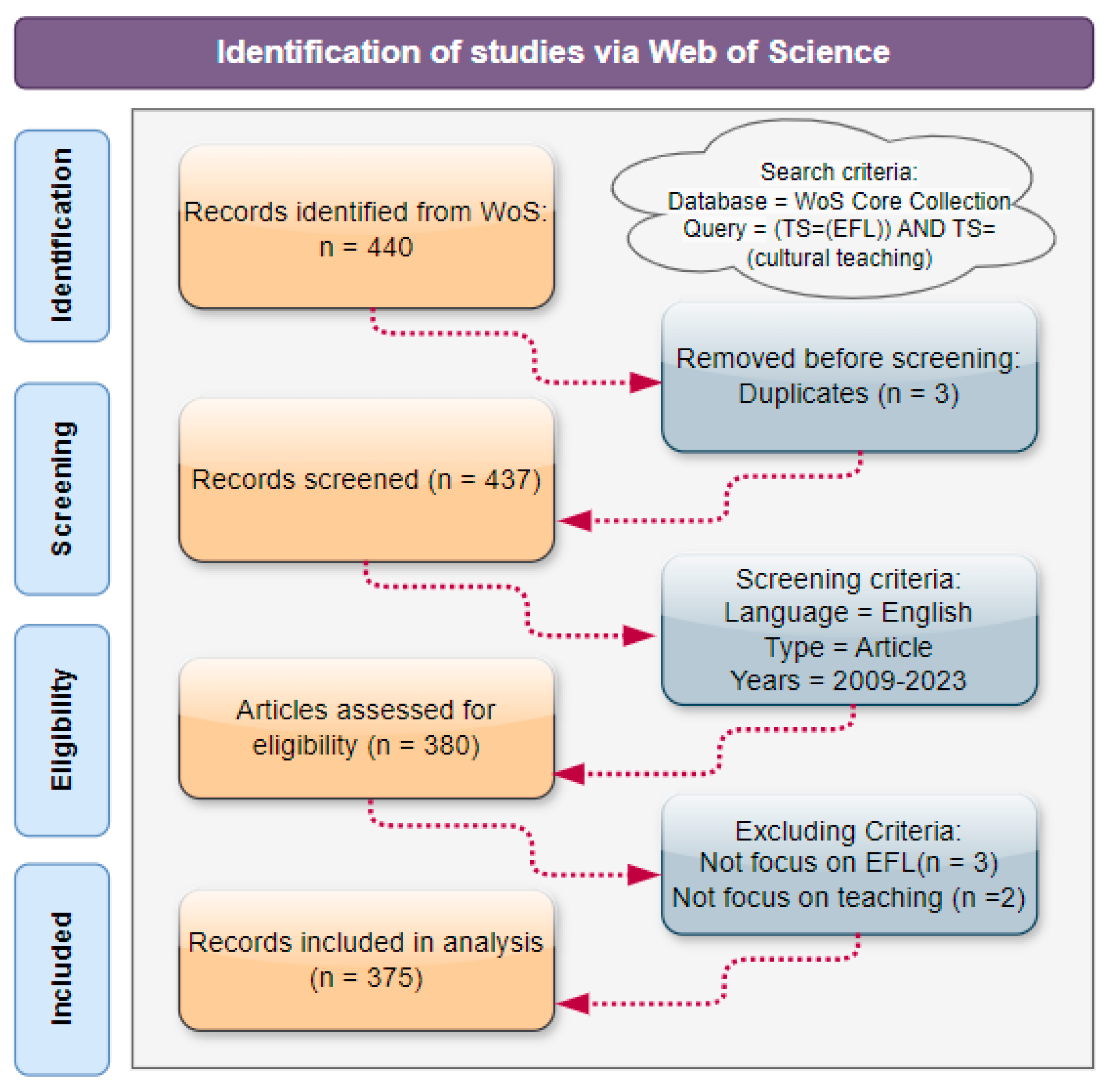
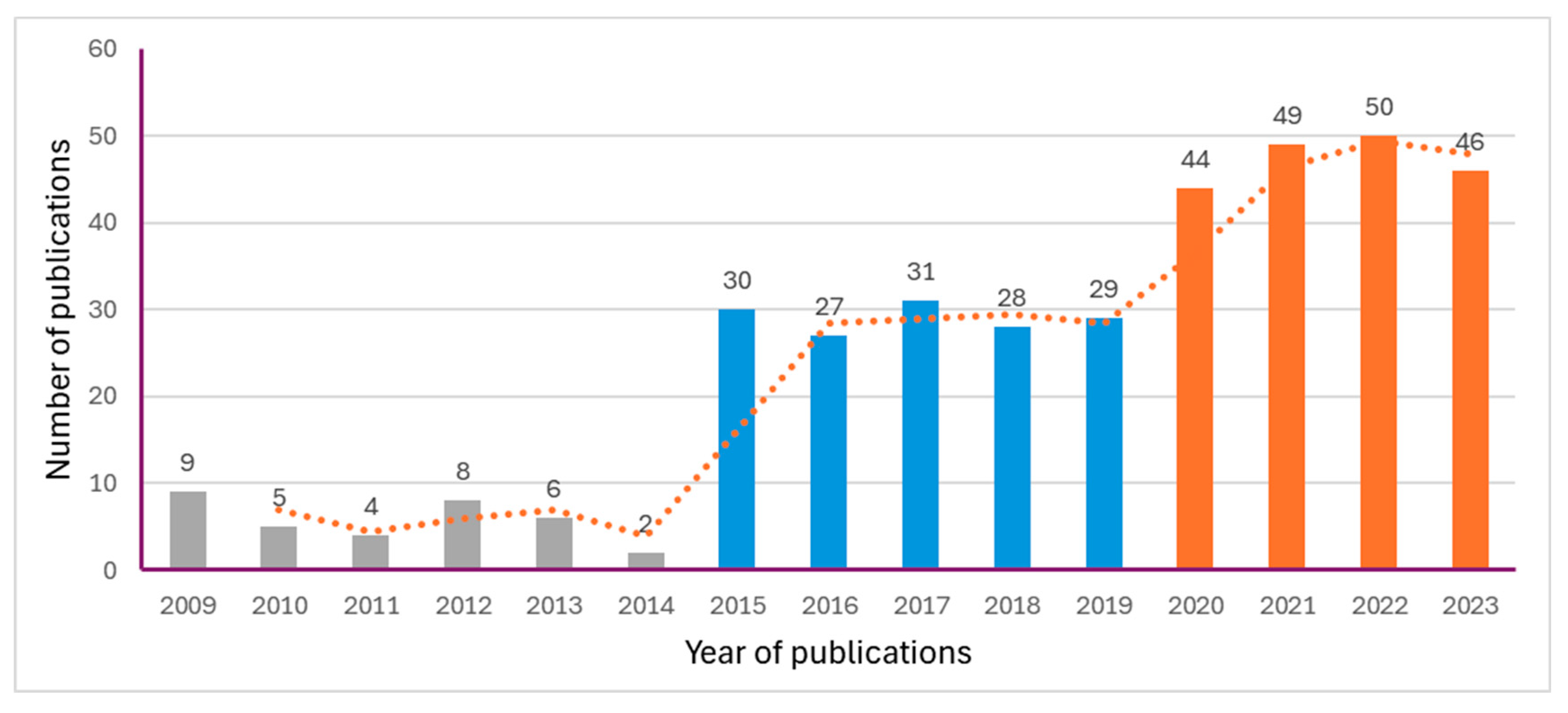
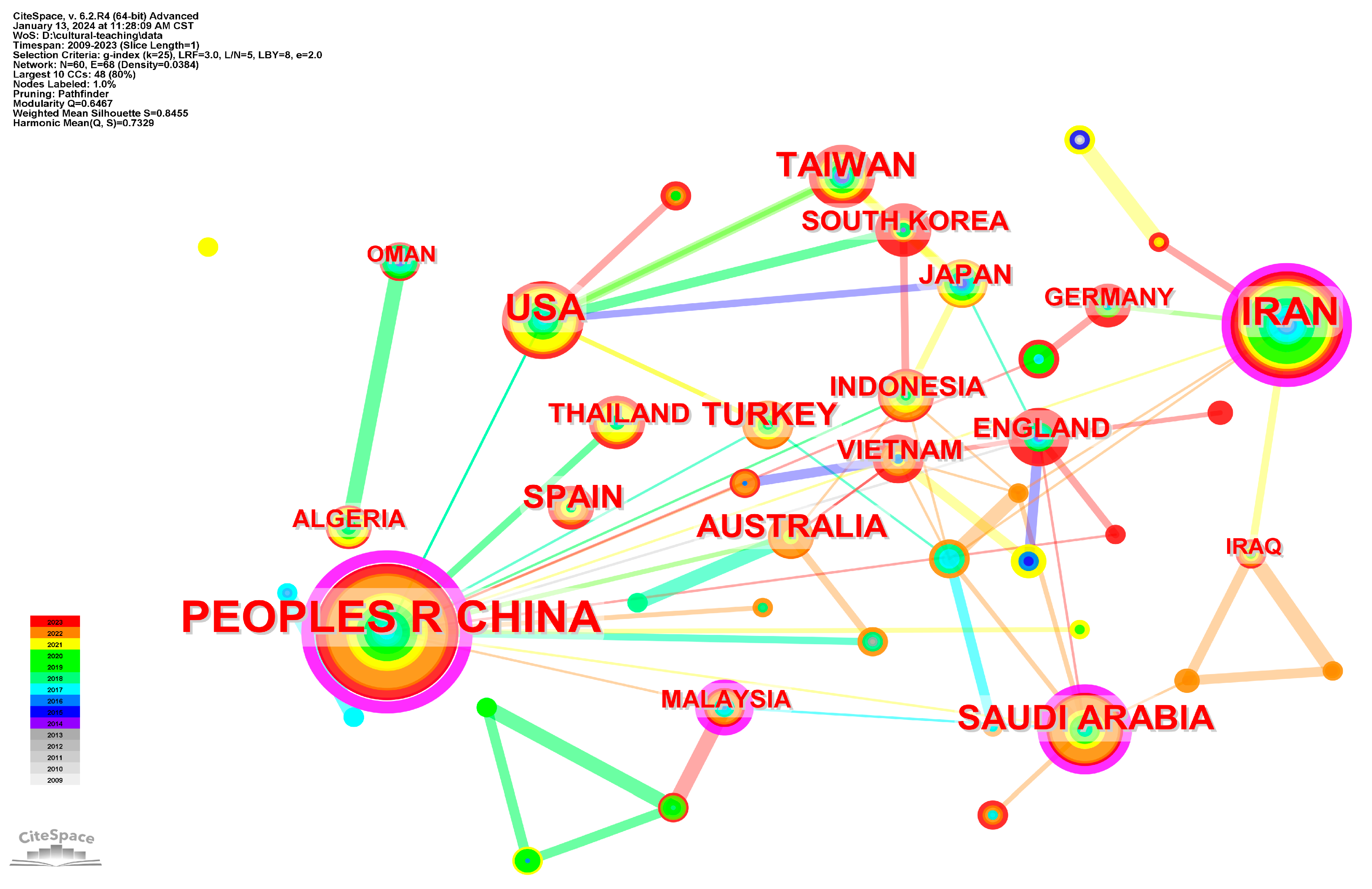
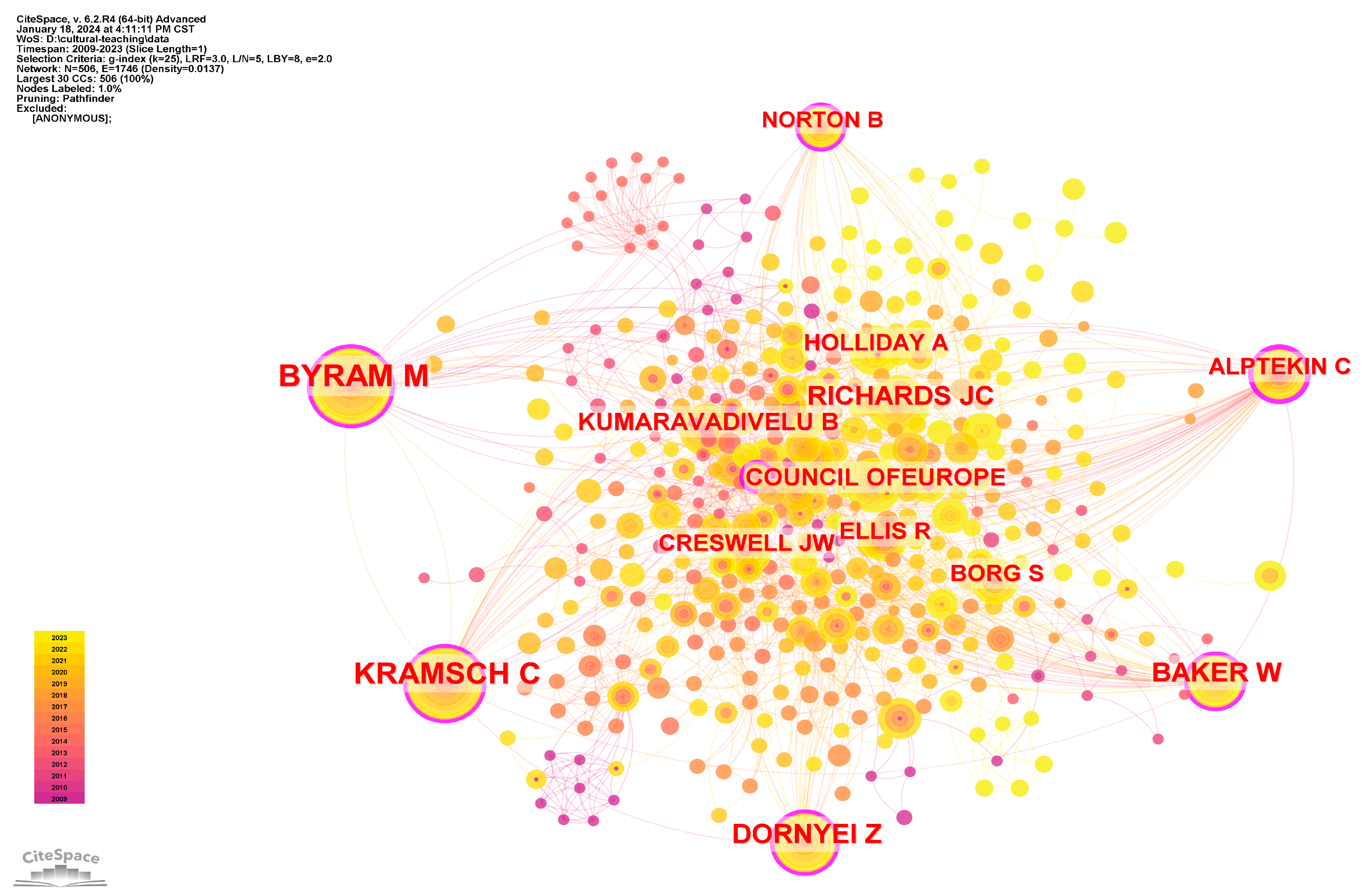
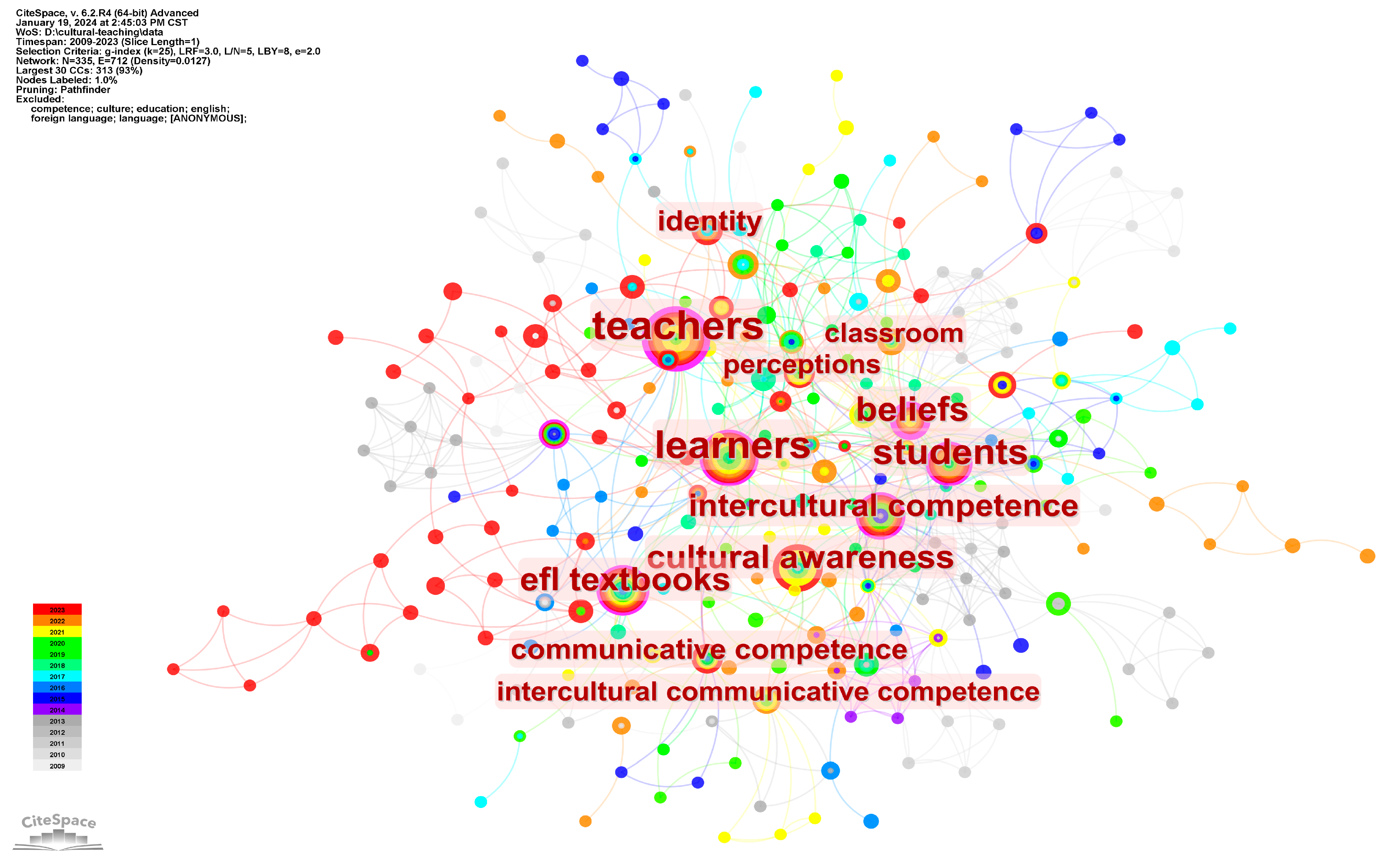
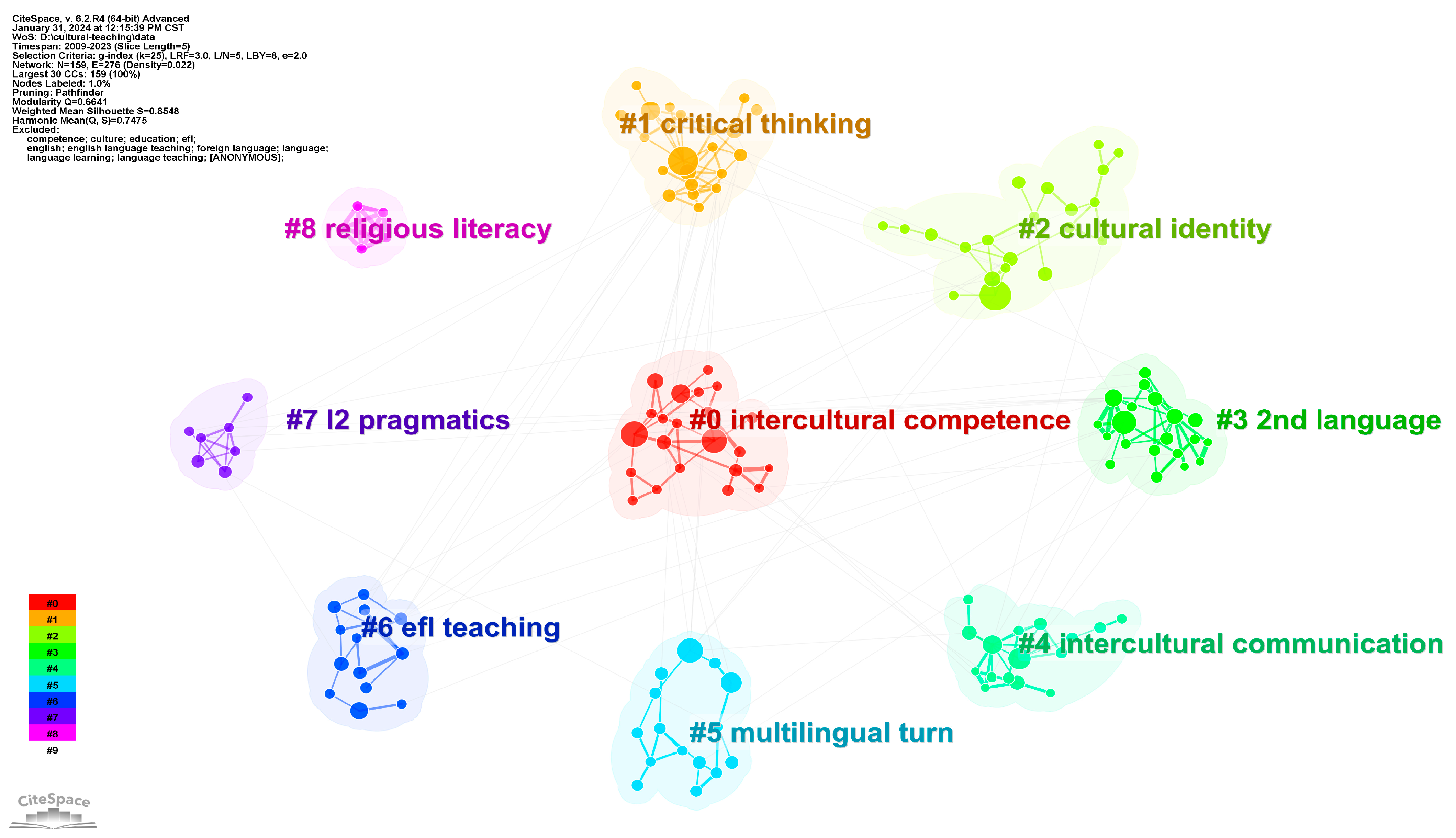
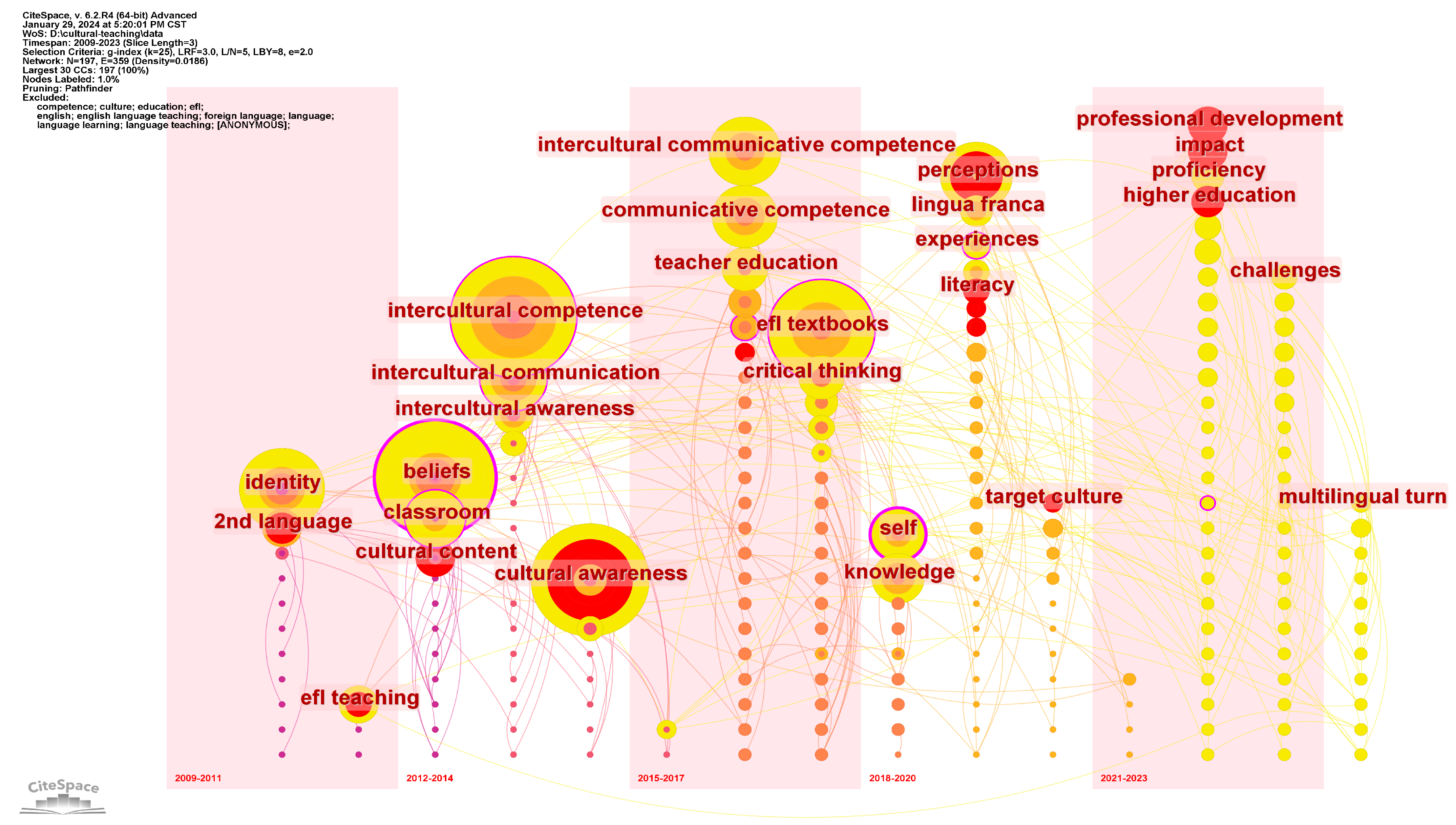
| Region | Publications | Centrality |
|---|---|---|
| PEOPLES R CHINA | 61 | 0.36 |
| IRAN | 42 | 0.11 |
| USA | 30 | 0.07 |
| SAUDI ARABIA | 25 | 0.18 |
| TAIWAN | 24 | 0.00 |
| TURKEY | 19 | 0.01 |
| AUSTRALIA | 18 | 0.05 |
| SPAIN | 17 | 0.00 |
| ENGLAND | 11 | 0.07 |
| INDONESIA | 11 | 0.06 |
| THAILAND | 11 | 0.00 |
| VIETNAM | 10 | 0.04 |
| JAPAN | 10 | 0.02 |
| SOUTH KOREA | 10 | 0.00 |
| Cited Author | Institution | Co-Citations | Centrality |
|---|---|---|---|
| BYRAM, Michael | Durham (UK) | 73 | 0.12 |
| KRAMSCH, Claire | Berkeley (USA) | 63 | 0.12 |
| DORNYEI, Zoltan | Nottingham (UK) | 39 | 0.11 |
| BAKER, Will | Southampton (UK) | 37 | 0.13 |
| RICHARDS, Jack C. | Victoria Univ (New Zealand) | 36 | 0.03 |
| COUNCIL OF EUROPE | EU | 25 | 0.05 |
| KUMARAVADIVELU B | San Jose Univ (USA) | 24 | 0.07 |
| ALPTEKIN, Cem | NY Univ (USA) | 23 | 0.22 |
| HOLLIDAY, Adrian | Canterbury Christ Church Univ (UK) | 23 | 0.05 |
| CRESWELL, John W. | Nebraska–Lincoln (USA) | 23 | 0.01 |
| BORG, Simon | Univ of Leeds (UK) | 21 | 0.08 |
| ELLIS, Rod | Curtin Univ (Australia) | 21 | 0.07 |
| NORTON, Bonny | UBC (Canada) | 19 | 0.13 |
| Cluster | Nodes | Year | Keywords (LLR Algorithm) |
|---|---|---|---|
| 0 | 22 | 2015 | intercultural competence (14.26, 0.001); cultural learning (7.18, 0.01); collaborative learning (7.18, 0.01); television (7.18, 0.01); chinese efl learners (7.18, 0.01) |
| 1 | 22 | 2016 | critical thinking (10.92, 0.001); efl learners (7.65, 0.01); efl teacher (7.26, 0.01); adult learning (7.26, 0.01); oral corrective feedback (3.8, 0.1) |
| 2 | 21 | 2019 | cultural identity (7.96, 0.005); teacher beliefs (7.96, 0.005); pre-service teacher education (7.96, 0.005); saudi arabia (7.96, 0.005); culturally responsive teaching (7.96, 0.005) |
| 3 | 20 | 2016 | 2nd language (8.33, 0.005); challenges (8.33, 0.005); knowledge (4.15, 0.05); teacher value beliefs (4.15, 0.05); behavioral patterns (4.15, 0.05) |
| 4 | 17 | 2016 | intercultural communication (22.86, 1.0E-4); cultural content (14.05, 0.001); critical discourse analysis (9.33, 0.005); elt textbooks (9.33, 0.005); intercultural awareness (5.72, 0.05) |
| 5 | 15 | 2019 | multilingual turn (13.24, 0.001); language learning (10.53, 0.005); english as a lingua franca (8.8, 0.005); migrant efl learners (8.8, 0.005); pluriliteracies education (8.8, 0.005) |
| 6 | 14 | 2017 | efl teaching (11.17, 0.001); teacher efficacy (10.3, 0.005); cross-cultural analysis (10.3, 0.005); impact (5.13, 0.05); individual differences (5.13, 0.05) |
| 7 | 7 | 2020 | l2 pragmatics (7.51, 0.01); elf (7.51, 0.01); business professionals (7.51, 0.01); belf (7.51, 0.01); metaphoric mapping (7.51, 0.01) |
| 8 | 5 | 2016 | religious literacy (9.71, 0.005); cultural dimensions (9.71, 0.005); curricular program (9.71, 0.005); observance of religion (9.71, 0.005); value spirituality (9.71, 0.005) |
Disclaimer/Publisher’s Note: The statements, opinions and data contained in all publications are solely those of the individual author(s) and contributor(s) and not of MDPI and/or the editor(s). MDPI and/or the editor(s) disclaim responsibility for any injury to people or property resulting from any ideas, methods, instructions or products referred to in the content. |
© 2024 by the authors. Licensee MDPI, Basel, Switzerland. This article is an open access article distributed under the terms and conditions of the Creative Commons Attribution (CC BY) license (https://creativecommons.org/licenses/by/4.0/).
Share and Cite
Wu, S.; Shafait, Z. Assessing EFL (English as Foreign Language) Education for Sustainable Development: Exploring the Cultural Teaching Literature. Eur. J. Investig. Health Psychol. Educ. 2024, 14, 2282-2299. https://doi.org/10.3390/ejihpe14080152
Wu S, Shafait Z. Assessing EFL (English as Foreign Language) Education for Sustainable Development: Exploring the Cultural Teaching Literature. European Journal of Investigation in Health, Psychology and Education. 2024; 14(8):2282-2299. https://doi.org/10.3390/ejihpe14080152
Chicago/Turabian StyleWu, Shujie, and Zahid Shafait. 2024. "Assessing EFL (English as Foreign Language) Education for Sustainable Development: Exploring the Cultural Teaching Literature" European Journal of Investigation in Health, Psychology and Education 14, no. 8: 2282-2299. https://doi.org/10.3390/ejihpe14080152
APA StyleWu, S., & Shafait, Z. (2024). Assessing EFL (English as Foreign Language) Education for Sustainable Development: Exploring the Cultural Teaching Literature. European Journal of Investigation in Health, Psychology and Education, 14(8), 2282-2299. https://doi.org/10.3390/ejihpe14080152







